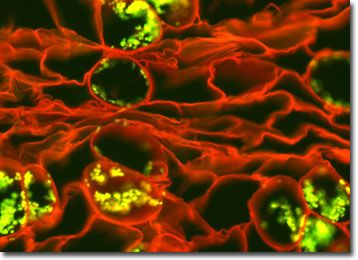Fluorescence Digital Image Gallery
Dutchman's Pipe
A native of central and eastern North America, Dutchman's pipe, Aristolochia durior, is a climbing vine and part of the birthwort family. The vine is planted often as a screen or cultivated as a porch vine because it is easy and quick to grow. It is distinguished by its large heart-shaped leaves and yellowish or purplish tubular flowers that resemble traditional Meerschaum smoking pipes.

One curious attribute of the flowers is that they give off an aroma reminiscent of rotting meat. Surprisingly, this smell is not meant to ward things away, but to attract the plant's key pollinators, insects and flies. The flowers act like a trap of sorts; after the insect has entered the tube it is unable to exit until pollination occurs. The tube is lined with stiff downward-pointing hairs that only relax if the insect has brought pollen from another flower. If the insect is carrying pollen, the anthers, which are the male sexual organs, uncover and load the insect with a fresh supply of pollen before it leaves.
Different species of Aristolochia vines can be found in Southeast Asia and Australia. Several species of the vines provide important food sources for the larvae of the birdwing butterfly, the largest butterfly in the world. The species of vines that are important to the birdwing butterfly have greatly declined in abundance due to urban development, farming, and forestry operations. This has contributed to the dramatic reduction of birdwing butterfly populations and has resulted in its placement on the threatened species list.
Dutchman's pipe has been introduced to Australia and is proving to be a very destructive species. The vine is similar to the native species in Australia, but contains different toxins in its leaves, which are poisoning the butterfly larvae that feed on the leaves. Even in the presence of native vine species, the birdwing butterflies are choosing the Dutchman's pipe species. In the land down under, the Dutchman's pipe might be branded as a butterfly killer, but ironically, in its native North American environment it has its own group of butterflies that depend on it to feed their larvae.
The specimen presented here was imaged with a Nikon Eclipse E600 microscope operating with fluorite and/or apochromatic objectives and vertical illuminator equipped with a mercury arc lamp. Specimens were illuminated through Nikon dichromatic filter blocks containing interference filters and a dichroic mirror and imaged with standard epi-fluorescence techniques. The specific filter for the Dutchman's pipe was Texas Red HYQ. Photomicrographs were captured with an Optronics MagnaFire digital camera system coupled to the microscope with a lens-free C-mount adapter.
BACK TO THE FLUORESCENCE DIGITAL IMAGE GALLERY
